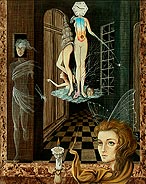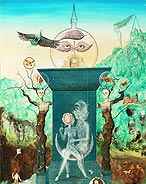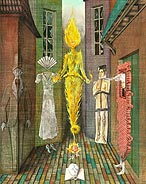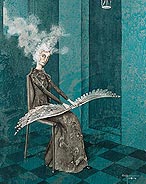 |
 |
In addition to the three works in this category and some of those shown in the categories below, an extensive inventory of Chavarria paintings and drawings in various sizes is presently available. Please call 305-444-4493 for details and photos.
Click here to see the artwork. |
 |
 |
Enrique Chavarria’s larger compositions tend to be complex, full of movement and life, enriched by his knowledge of nature and wildlife. Unlike other surrealists and neo-surrealists, he often offers a humorous commentary on his subjects, such as a psychiatrist with the face of an owl, precariously mounted on a unicycle, seeking his way through a maze of symbols to a couch. According to Cynthia Hollis of the Florida International Museum, his paintings allow us to delve into other universes, “complete with their own cosmologies and laws of science.”
Click here to see the artwork. |
 |
 |
| Enrique Chavarria’s paintings and drawings have been exhibited at the Mary Brogan Museum of Art and Science in Tallahassee, Florida International Museum in St. Petersburg, the Miami Museum of Science & Planetarium and ArtSpace/Virginia Miller Galleries. His iconography, reflecting a deep knowledge of myth, fantasy, and natural history, often is infused with a concern for the human condition. The artist felt that his fantastic art may help “gain awareness of a world that is destroying itself, and find oneself with a miracle, to discover hope.” Click here to see the artwork. |
 |
 |
Enrique Chavarria (1927-1998) was a Mexican painter whose neo-surrealist works occasionally remind one of two well-known Mexican artists, Remedios Varo and Leonora Carrington. A recluse, Chavarria read widely, and the dreamlike qualities of his fantasies reflect his wide-ranging scholarly interests from literary classics to the magical realism of Latin America. Works of neo-surrealists such as Varo, Carrington and Chavarria tend to be less personal and analytical than the classic surrealism of Salvador Dalí.
Click here to see the artwork. |
|
